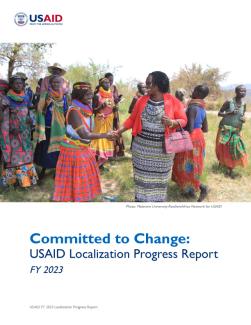There is widespread consensus that development and humanitarian assistance must enable local actors to set their own agendas, develop solutions, and bring their capacities, leadership, and resources to bear to make those solutions a reality. Experience has shown that local leadership is critical for greater equity, effectiveness, and sustainability. To continue to move toward a model of locally led and inclusive development, USAID has embraced localization, a set of actions that shift how the Agency works to put local actors in the lead and strengthen local systems.
Over the last two years, USAID has been working toward two Agency-wide localization targets set out by Administrator Power in 2021. First, by Fiscal Year (FY) 2025, USAID will direct a quarter of its funding directly to local partners. Second, by 2030, at least half of USAID programs will create space for local actors to exercise leadership over priority setting, program design, implementation, and defining and measuring results. This report is the second status update on USAID’s progress toward those targets. It also details a range of recent efforts that will help underpin future progress.
In FY 2023, USAID obligated $1.5 billion to local partners and another $68 million to regional partners. USAID also provided $156 million through government-to-government (G2G) assistance agreements. The percentage of funding going directly to local partners in FY 2023 declined slightly from last year, from 10.2 to 9.6, though other trends in the data point to signs of progress. Both the number of new awards to local partners and the number of local partners with whom USAID works have increased annually over the last three years and reached new highs in FY 2023. By sector, health stands out, with more than 20 percent of health funding going to local partners in FY 2023. Africa remains the region with the highest proportion of direct local funding (22 percent).
In addition to shifting funding, USAID is also focused on shifting power to local actors and communities. Over the last year—informed by consultations with a broad range of external and internal stakeholders—USAID developed and piloted a new Locally Led Programs indicator that tracks the extent to which USAID programs employ a set of “good practices” that advance locally led development over the life of a project. These practices include approaches such as co-creation; participatory monitoring, evaluation, and learning processes; and accountability and feedback mechanisms. In FY 2023, USAID piloted this metric across approximately half of the Agency’s portfolio. Overall, approximately half of the programs assessed in the pilot utilized at least two good practices. These strong results present an opportunity to raise USAID’s ambition around how the Agency elevates and measures local leadership in its programs. Lessons from the pilot will also inform adjustments to the indicator before USAID applies the metric Agency-wide in 2024.
Targets alone do not drive progress. Over the last year, USAID has undertaken a wide range of efforts to advance locally led development and humanitarian response. The Agency has developed new tools and resources to support staff to work in more locally led ways. It has reduced barriers to entry for local partners through increased outreach, expanded use of local languages, more flexible and tailorable pre-award assessments for local partners, and more. USAID is also focused on being a better partner by expanding the use of mechanisms with lower compliance burdens, taking steps to support partners’ full cost recovery, and encouraging staff to reduce reporting burdens.
Localization also requires systems and culture change across the whole Agency. While progress on a reform effort of this magnitude will take place incrementally, the momentum and signs of progress are there, even as USAID faces more work ahead to create more equitable, inclusive partnerships that produce more sustainable impact.

